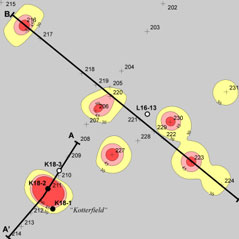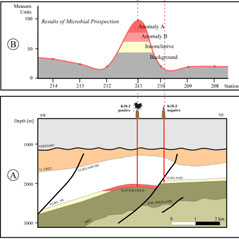K18 – Dutch sector of the North Sea
Methodology
In 1996 sediment samples were taken for microbiological, geochemical and isotopic measurements at the North Sea (Dutch blocks K18 / L16). 32 sediment samples were taken along seismic profiles, in order to be able to directly compare the microbiological and seismic data. One sample track (A - A') was extended across the producing “Kotter” field for calibration purposes. The profile B - B' crosses almost the entire investigation area in a NW - SE direction.
Microbiological analyses were carried out without any knowledge of the geological structure or of the location of the “Kotter” field or the wells. The “Kotter” field is located in the Vlieland Series of the Lower Cretaceous. The following comparison of the geological and microbial results was made upon completion of the microbiological investigations.
Results
The MPOG® result for oil along two profiles A and B is shown in figure 1.
Hydrocarbons at the Kotterfield are accumulated in an oil trap at a depth of about 2,500 m. Only dissolved low hydrocarbons were detected in the oil field; a free gas cap does not exist. Positions of the successful well K18-2 (station 211) and of the dry well K18-3 (near station 210) are shown in the figure. By the microbiological measurements the reservoir was localized at station 211. Furthermore, there are no other microbial indications along this profile A - A'. Isotope measurements of adsorbed gases in the upper sediment around station 211 confirmed with a d13C value of -36.6 ‰ PDB that methane is of thermogenetic origin and is derived from the kerogen type II of marine source rock.
Summary
Figure 2 (section B) shows significant microbial anomaly "A", which occurs directly and vertically above the oil field. This has been confirmed by the successful well K18-2 (section A). The northern border of the oil trap is defined by the dry hole K18-3. The background level was determined at the corresponding station 210. A displacement of the microbial anomalies by the existing faults has not been detected. Significantly increased cell numbers of hydrocarbon oxidizing bacteria and biochemical activities also clearly reflect the MPOG® - anomaly at station 211.
In contrast to a significant oil indication, a gas indication was not detected at the “Kotter” field. The measured values of methane oxidizers are in the normal range of the background values. According to our experience from other oil and gas fields, this corresponds to the lack of a free gas cap in the “Kotter” field.
Section C (figure 2 )shows the geochemical results along profile A –A’. Measurements of adsorbed gases in sediment are in contrast to results of microbial oil survey. The lowest hydrocarbon concentrations were detected vertically above the field. The maximum values were in the margin area. This phenomenon of geochemical prospecting which has also been detected at other fields is repeatedly described in literature as “Halo-effect”. One possible reason for a “Halo-effect” could be seen in intensive microbial hydrocarbon degradation process on top of reservoirs.


